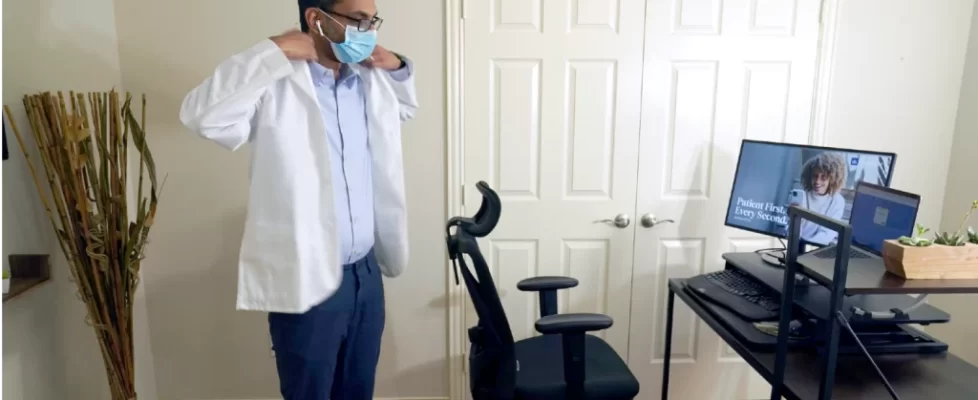Congress must ensure continued access to telehealth services
When the pandemic first hit in early 2020, Americans were faced with unprecedented challenges. Accessing safe and timely health care services was something that everyone from seniors to new parents struggled with as offices shuttered and millions quarantined. Health care providers had to swiftly adapt to the changing environment to provide care, and officials stepped up to increase flexibilities and give patients and providers as many tools as possible to keep everyone safe, while maintaining access to necessary health care. Providing health care virtually through telemedicine was a popular solution that helped deliver care to patients in the safety of their homes. `
The pandemic demonstrated the troubling extent to which our laws and regulations lag behind market and technology innovation. Telehealth and remote patient monitoring services were already providing unique opportunities for both patients and providers. But those who desired to use these services before the pandemic faced a multitude of logistical complexities which included restrictions on where each party must be located, limits on the type of technology interface they must use, and miscellaneous rules that prevented general telehealth access for patients. The pandemic showed that a 19th century “house call” could be utilized in present day using both audio and visual modern technologies thanks to the CARES Act. Many of the telehealth policies and flexibilities in this legislation meant that more patients could be treated without having to travel to a brick-and-mortar facility. This was and is still groundbreaking for seniors, working parents, low-income households, and others who do not have the time or resources to travel long distances to receive care. Additionally, practitioners, whether they provide primary care or behavioral and mental health care, benefit from increased workforce flexibility, allowing them to conduct examinations via phone or video. Expanding access to telehealth is a badly needed step to relieve pressures on a medical field already strained under conditions with too few workers and too few beds.
These are just some of the many reasons that federal, state, and local leaders should be collaborating to expand access to telehealth and remote care services. Fortunately, this is a bipartisan cause, and we’ve already led our colleagues to enact bold telehealth policies several times this year. But there is more work to do.
Our bill, the Telehealth Expansion Act of 2021, will provide certainty to folks seeking to have their telehealth services covered by their High Deductible Health Plans coupled with Health Savings Accounts (HDHP-HSA) without first reaching a deductible. This provision was originally included in the bipartisan CARES Act and was not tied to the Public Health Emergency (PHE). Unfortunately, this first-dollar coverage of telehealth services expired on Dec. 31, 2021 and was notably the first telehealth flexibility to expire before the end of the PHE. This meant that employees with HDHP-HSAs, who had plan years starting on Jan. 1, 2022, were no longer able to receive telehealth services unless they reached an expensive deductible. Many found themselves having to make a financial trade off to access telehealth services, especially for virtual behavioral and mental health care, and we are uncertain if those who utilized these services ever returned for their next virtual appointment. While Congress was able to get an extension of the policy in the March 2022 Omnibus bill for the duration of this calendar year, our legislation is still needed, as it provides permanent first-dollar coverage for telehealth services and will expand and enable virtual care for millions of hardworking Americans.
More than 32 million Americans use HDHP-HSA plans. Over half of individuals with an HSA live in zip codes where the median income is below $75,000 annually. Without the solution offered by our bill, these families could be forced to meet deductible thresholds of at least $1,400 for an individual or $2,800 for a family before they can access telehealth services. In a time where families are stretching every dollar to make ends meet, we should be removing arbitrary barriers to care and increasing flexibility wherever possible.
During this period of uncertainty, especially for virtual behavioral and mental health care, it’s tough to know if those who utilized these services ever returned for their next virtual appointment. While Congress was able to get an extension of the policy in the Omnibus for the duration of the year, our legislation of permanent first-dollar coverage of HDHP-HSA telehealth will expand and enable virtual care for millions of hardworking Americans.
The provision in question has meant that important telehealth services have been covered without the patient first having to meet their deductible—ensuring that millions of Americans with employment-based health coverage have had access to important telehealth services during the COVID-19 pandemic. Millions have been able to access both primary and behavioral and mental health services via telehealth, which is more important in the wake of the pandemic than ever before. Employees have been able to receive care without taking time off work for appointments, ensuring that they aren’t forced to choose between keeping their appointment or feeding their families. Increased flexibility and access mean increased care, which means fewer exacerbated conditions requiring emergency treatment and taking up hospital beds.
Employers, too, are overwhelmingly supportive of the benefits of a safe harbor provision. According to a recent survey by the Employee Benefit Research Institute, about 96 percent of employers adopted pre-deductible coverage for telehealth services because of this temporary safe harbor. The bottom line: employers and employees alike want continued flexibility for telehealth access. The pandemic taught us many things, one of which is that telehealth has the potential to revolutionize health care as we know it and make it more affordable and more accessible for millions of Americans.
This is a worthy cause, and we encourage our colleagues in Congress to join us as we advocate for common sense, bipartisan policies that can help increase access and affordability for patients by supporting the Telehealth Expansion Act of 2021.

